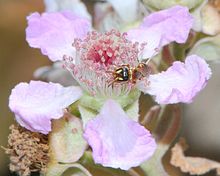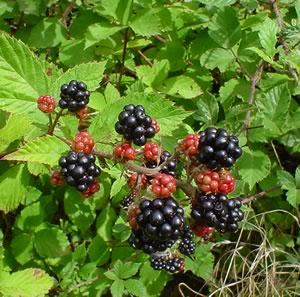
Rubus is a large and diverse genus of flowering plants in the rose family, Rosaceae, subfamily Rosoideae, with over 1,350 species, commonly known as brambles.

Rubus chamaemorus is a species of flowering plant in the rose family Rosaceae, native to cool temperate regions, alpine and arctic tundra and boreal forest. This herbaceous perennial produces amber-colored edible fruit similar to the blackberry. English common names include cloudberry, nordic berry, bakeapple, knotberry and knoutberry, aqpik or low-bush salmonberry, and averin or evron.

The raspberry is the edible fruit of a multitude of plant species in the genus Rubus of the rose family, most of which are in the subgenus Idaeobatus. The name also applies to these plants themselves. Raspberries are perennial with woody stems.

Rubus idaeus is a red-fruited species of Rubus native to Europe and northern Asia and commonly cultivated in other temperate regions.

Rubus spectabilis, the salmonberry, is a species of bramble in the rose family Rosaceae, native to the west coast of North America from west-central Alaska to California, inland as far as Idaho. Like many other species in the genus Rubus, the salmonberry plant bears edible fruit, typically yellow-orange or red in color, resembling raspberries in appearance.

The burning bush refers to an event recorded in the Jewish Torah. It is described in the third chapter of the Book of Exodus as having occurred on Mount Horeb. According to the biblical account, the bush was on fire, but was not consumed by the flames, hence the name. In the biblical narrative, the burning bush is the location at which Moses was appointed by Yahweh to lead the Israelites out of Egypt and into Canaan.

Rubus leucodermis, also called whitebark raspberry or blackcap raspberry, is a species of Rubus native to western North America.

Rubus ursinus is a North American species of blackberry or dewberry, known by the common names California blackberry, California dewberry, Douglas berry, Pacific blackberry, Pacific dewberry and trailing blackberry.

Rubus rosifolius,, also known as roseleaf bramble, Mauritius raspberry, thimbleberry,Vanuatu raspberry and bramble of the Cape is a prickly subshrub native to rainforest and tall open forest of the Himalayas, East Asia, and eastern Australia.

Rubus parvifolius, called Japanese bramble, or Australian raspberry in the United States or native raspberry in Australia is a species of plant in the rose family. It is a scrambling shrub native to eastern Asia and Australia. It has also become naturalized in a few scattered locations in the United States.
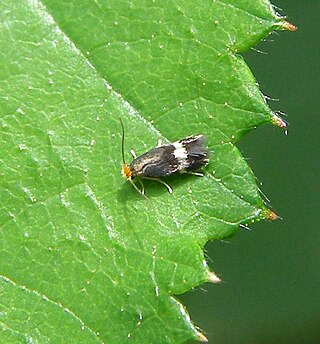
Stigmella aurella is a moth of the family Nepticulidae. It is found in Europe from Ireland to Ukraine, the Near East, and the eastern part of the Palearctic realm.

Rubus ulmifolius is a species of wild blackberry known by the English common name elmleaf blackberry or thornless blackberry and the Spanish common name zarzamora. It is native to Europe and North Africa, and has also become naturalized in parts of the United States, Australia, and southern South America.

Lambertianin C is an ellagitannin.

Sanguisorbic acid is a constituent of some ellagitannins. It is constituted by a hexahydroxydiphenic acid unit linked by an O-C bond to a gallic acid. The differences with its isomers, valoneic acid and nonahydroxytriphenic acid, are that the hydroxyl that links the hexahydroxydiphenoyl (HHDP) group to the galloyl group belongs to the galloyl group in valoneic acid, while in nonahydroxytriphenic acid, the hexahydroxydiphenic acid unit is linked by a C-C bond to gallic acid.
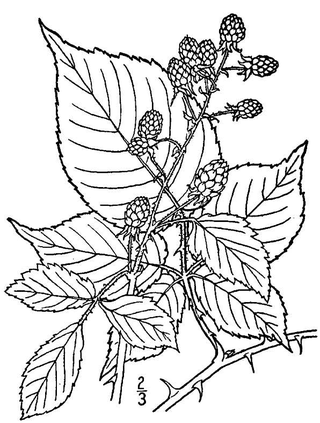
Rubus allegheniensis is a North American species of highbush blackberry in section Alleghenienses of the genus Rubus, a member of the rose family. It is the most common and widespread highbush blackberry in eastern and central North America. It is commonly known as Allegheny blackberry.
Rubus fraternalis is an uncommon North American species of flowering plant in the rose family. It has been found in Québec and in the northeastern United States.
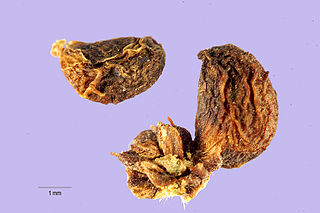
Rubus macrophyllus is a European species of bramble in the rose family. It can be found across Europe, from Ireland to Bulgaria. There are reports of the species having become naturalized in the States of Washington and Oregon in the northwestern United States.

Diastrophus rubi is a species of gall wasp in the family Cynipidae that live on the stems of bramble. The insect was first described by the German entomologist Peter Friedrich Bouché in 1834 and is found in Europe.
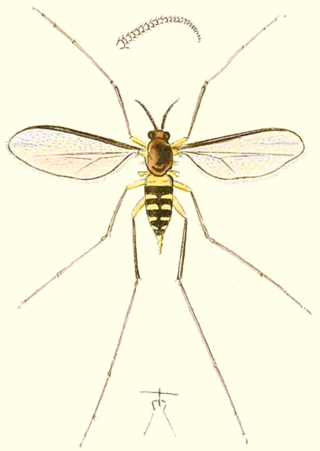
Lasioptera rubi is a species of gall midge in the family Cecidomyiidae and is found in Europe. It was first described in 1803 by the German priest, botanist and entomologist, Franz von Paula Schrank. The larvae feed within the tissue of brambles, creating abnormal plant growths known as galls.
Dasineura plicatrix is a species of gall midge, an insect in the family Cecidomyiidae, found in Europe. It was described by the German entomologist Friedrich Hermann Loew in 1850. The larvae feed within the tissue of bramble leaves, creating an abnormal growth known as a plant gall.
